Infiniti QX56 User Manual

For your safety, read carefully and keep in this vehicle.
2010 Infiniti QX56 Owner’s Manual

FOREWORD |
READ FIRST—THEN DRIVE SAFELY |
Welcome to the growing family of new INFINITI owners. This vehicle is delivered to you with confidence. It was produced using the latest techniques and strict quality control.
This manual was prepared to help you understand the operation and maintenance of your vehicle so that you may enjoy many miles (kilometers) of driving pleasure. Please read through this manual before operating your vehicle.
A separate Warranty Information Booklet explains details about the warranties covering your vehicle. The “INFINITI Service and Maintenance Guide” explains details about maintaining and servicing your vehicle. Additionally, a separate Customer Care/Lemon Law Booklet (U.S. only) will explain how to resolve any concerns you may have with your vehicle, as well as clarify your rights under your state’s lemon law.
Your INFINITI dealership knows your vehicle best. When you require any service or have any questions, they will be glad to assist you with the extensive resources available to them.
Additionally , a separate Customer Care and Lemon Law Information Booklet will explain how to resolve any concerns you may have with your vehicle, as well as clarify your rights under your state’s lemon law.
INFINITI is dedicated to providing a satisfying ownership experience for as long as you own your car. Should you have any questions regarding your INFINITI or your INFINITI dealer, please contact our Consumer Affairs department at 1–800–662–6200. In Canada 1–800–361–4792. Thank you.
Before driving your vehicle, please read this Owner’s Manual carefully. This will ensure familiarity with controls and maintenance requirements, assisting you in the safe operation of your vehicle.
WARNING
IMPORTANT SAFETY INFORMATION REMINDERS FOR SAFETY!
Follow these important driving rules to help ensure a safe and comfortable trip for you and your passengers!
●NEVER drive under the influence of alcohol or drugs.
●ALWAYS observe posted speed limits and never drive too fast for conditions.
●ALWAYS give your full attention to driving and avoid using vehicle features or taking other actions that could distract you.
●ALWAYS use your seat belts and appropriate child restraint systems. Pre-teen children should be seated in the rear seat.
●ALWAYS provide information about the proper use of vehicle safety features to all occupants of the vehicle.
●ALWAYS review this Owner’s Manual for important safety information.
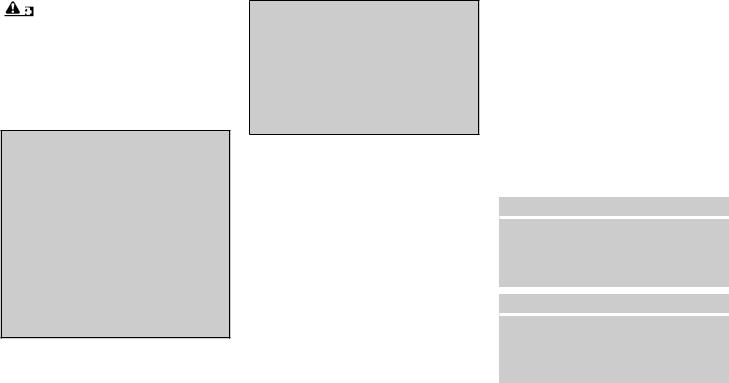
For descriptions specified for four-wheel drive models, a mark is placed at the beginning of the applicable sections/items.
As with other vehicles with features for off-road use, failure to operate four-wheel drive models correctly may result in loss of control or an accident. Be sure to read “Driving safety precautions” in the “Starting and driving” section of this manual.
ON-PAVEMENT AND OFF-ROAD DRIVING
This vehicle will handle and maneuver differently from an ordinary passenger car because it has a higher center of gravity for off-road use. As with other vehicles with features of this type, failure to operate this vehicle correctly may result in loss of control or an accident.
Be sure to read “On-pavement and offroad driving precautions”, and “Avoiding collision and rollover”, and “Driving safety precautions”, in the “Starting and driving” section of this manual.
MODIFICATION OF YOUR VEHICLE
This vehicle should not be modified. Modification could affect its performance, safety or durability, and may even violate governmental regulations. In addition, damage or performance problems resulting from modifications may not be covered under INFINITI warranties.
WHEN READING THE MANUAL
This manual includes information for all options available on this model. Therefore, you may find some information that does not apply to your vehicle.
All information, specifications and illustrations in this manual are those in effect at the time of printing. INFINITI reserves the right to change specifications or design without notice and without obligation.
IMPORTANT INFORMATION ABOUT THIS MANUAL
You will see various symbols in this manual. They are used in the following ways:
WARNING
This is used to indicate the presence of a hazard that could cause death or serious personal injury. To avoid or reduce the risk, the procedures must be followed precisely.
CAUTION
This is used to indicate the presence of a hazard that could cause minor or moderate personal injury or damage to your vehicle. To avoid or reduce the risk, the procedures must be followed carefully.

APD1005
If you see this symbol, it means “Do not do this” or “Do not let this happen.”
If you see a symbol similar to these in an illustration, it means the arrow points to the front of the vehicle.
Arrows in an illustration that are similar to these indicate movement or action.
Arrows in an illustration that are similar to these call attention to an item in the illustration.
CALIFORNIA PROPOSITION 65 WARNING
WARNING
Engine exhaust, some of its constituents, and certain vehicle components contain or emit chemicals known to the State of California to cause cancer and birth defects or other reproductive harm. In addition, certain fluids contained in vehicles and certain products of component wear contain or emit chemicals known to the State of California to cause cancer and birth defects or other reproductive harm.
CALIFORNIA PERCHLORATE ADVISORY
Some vehicle parts, such as lithium batteries, may contain perchlorate material. The following advisory is provided: “Perchlorate Material – special handling may apply, See www.dtsc.ca.gov/hazardouswaste/perchlorate.”
BLUETOOTH is a trademark owned by Bluetooth SIG, Inc., U.S.A. and licensed to Xanavi Informatics Corporation.
Gracenote is a registered trademark of Gracenote, Inc. The Gracenote logo and logo type, and the “Powered by Gracenote” logo are trademarks of Gracenote.
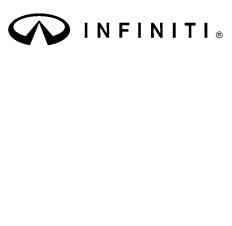
XM Radio requires subscription, sold separately after first 90 days. Not available in Alaska, Hawaii or Guam. For more information, visit www.xmradio.com.
© 2009 NISSAN NORTH AMERICA, INC.
All rights reserved. No part of this Owner’s Manual may be reproduced or stored in a retrieval system, or transmitted in any form, or by any means, electronic, mechanical, photocopying, recording or otherwise, without the prior written permission of Nissan North America, Inc.
Table of
Contents
Illustrated table of contents |
|
0 |
|
|
|
|
|
|
Safety—Seats, seat belts and supplemental restraint system |
|
1 |
|
|
|
|
|
|
Instruments and controls |
|
2 |
|
|
|
|
|
|
Pre-driving checks and adjustments |
|
3 |
|
|
|
|
|
|
Monitor, climate, audio, phone and voice recognition systems |
|
4 |
|
|
|
|
|
|
Starting and driving |
|
5 |
|
|
|
|
|
|
In case of emergency |
|
6 |
|
|
|
|
|
|
Appearance and care |
|
7 |
|
|
|
|
|
|
Maintenance and do-it-yourself |
|
8 |
|
|
|
|
|
|
Technical and consumer information |
|
9 |
|
|
|
Index |
|
10 |
|
|
|

0 Illustrated table of contents
Air bags, seat belts and child restraints . . . . . . . . . . . . . . 0-2 Exterior front . . . . . . . . . . . . . . . . . . . . . . . . . . . . . . . . . . . . . . 0-3 Exterior rear. . . . . . . . . . . . . . . . . . . . . . . . . . . . . . . . . . . . . . . 0-4 Passenger compartment . . . . . . . . . . . . . . . . . . . . . . . . . . . 0-5
Instrument panel. . . . . . . . . . . . . . . . . . . . . . . . . . . . . . . . . . . 0-6 Engine compartment check locations . . . . . . . . . . . . . . . . 0-8 Warning/indicator lights . . . . . . . . . . . . . . . . . . . . . . . . . . . . 0-9
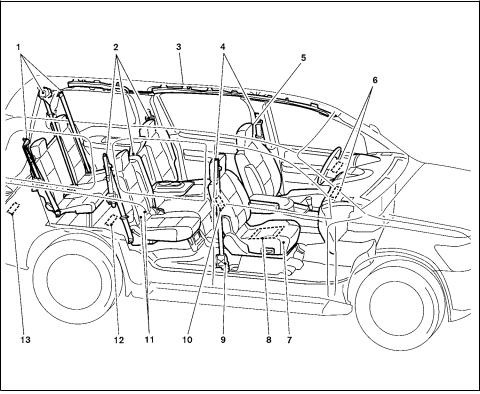
AIR BAGS, SEAT BELTS AND CHILD
RESTRAINTS
1. 3rd row bench seat belts (P. 1-20) 2. 2nd row seat belts (P. 1-20)
3. Roof-mounted curtain side-impact and rollover supplemental air bag (P. 1-52)
4. Front seat belts (P. 1-20)
5. Head Restraints (P. 1-7)
6. Supplemental front-impact air bags
(P.1-52)
7. Seats (P. 1-2)
8. Occupant classification sensor (pressure sensor) (P.1-59)
9. Seat belt with pretensioner (P. 1-65)
10. Front seat-mounted side-impact supplemental air bag (P. 1-52)
11. LATCH (Lower Anchors and Tethers for CHildren) system (P. 1-33)
12. 2nd row seat top tether strap anchor (P. 1-47)
13. 3rd row seat top tether strap anchor (P. 1-48)
See the page number indicated in parentheses for operating details.
WII0154
0-2 Illustrated table of contents

EXTERIOR FRONT
1. Engine hood (P. 3-18)
2. Windshield wiper and washer switch (P. 2-22)
3. Windshield (P. 8-19)
4. Power windows (P. 2-47)
5. Door locks, INFINITI Intelligent Key™, keys (P. 3-4, 3-7, 3-2)
6. Mirrors (P. 3-27)
7. Tire pressure (P. 9-11)
8. Flat tire (P. 6-2)
9. Tire chains (P. 8-39)
10. Replacing bulbs (P. 8-29)
11. Headlight switch (P. 2-24)
12. Fog light switch and turn signal switch (P. 2-29, P. 2-24)
13. Tow hooks (P. 6-13)
See the page number indicated in parentheses for operating details.
WII0121
Illustrated table of contents 0-3
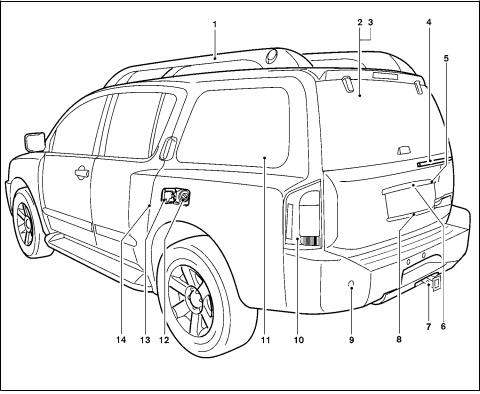
EXTERIOR REAR
1. Roof rack (P. 2-46)
2. Rear window defroster (P. 2-24)
3. Glass hatch (P. 3-22)
4. Rear window washer (P.2-23)
5. Glass hatch release (P. 3-22)
6. Rearview monitor (P.4-18)
7. Towing/Trailer hitch (if so equipped)
(P.9-16)
8. Lift gate release (P. 3-18)
9. Rear sonar system (P.5-52)
10. Replacing bulbs (P. 8-29)
11. Power vent windows (P.2-50)
12. Fuel-filler cap, fuel recommendation (P. 3-23, P. 9-3)
13. Fuel-filler door (P. 3-23)
14. Child safety rear door locks (P. 3-6)
See the page number indicated in parentheses for operating details.
WII0122
0-4 Illustrated table of contents
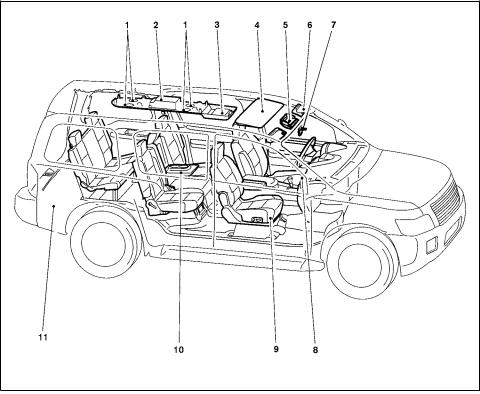
PASSENGER COMPARTMENT
1. Rear ventilators (P. 4-21)
2. Storage (P. 2-36)
3. INFINITI Mobile Entertainment System (MES) (if so equipped) (P. 4-54)
4. Moonroof (P. 2-50)
5. Map lights (P. 2-54)
6. Sun visors (P. 3-26)
7. HomeLink (P. 2-54)
8. Glove box (P. 2-36)
9. Seats (P. 1-2)
10. Cup holders (P. 2-40)
11. Luggage storage (P. 2-43)
See the page number indicated in parentheses for operating details.
LII0041
Illustrated table of contents 0-5
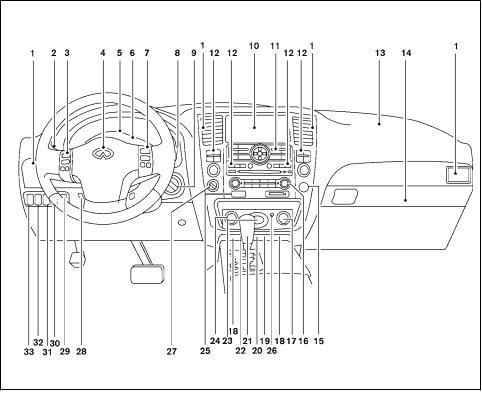
INSTRUMENT PANEL
WIC1379
1.Vents (P. 4-21)
2.Headlight/fog light/turn signal switch (P. 2-24)
3.Steering wheel switch for audio control and Bluetooth Hands-Free Phone System (P. 4-51, 4-70)
4.Driver supplemental air bag/horn (P. 1-52, P.2-30)
5.Meters, gauges and warning/indicator lights (P. 2-3, 2-8)
6.Instrument brightness control (P. 2-28)
7.Cruise control main/set switches
(if so equipped) and Intelligent cruise control main/set switches
(if so equipped) (P. 5-17, P.5-19)
8.Windshield wiper/washer switch and rear window wiper/washer switch (P. 2-22, P. 2-23)
9.Ignition switch (P. 5-9)
10.Navigation system* (P. 4-2)
11.Navigation system* controls (P. 4-2)
12.Audio system controls (P. 4-26)
13.Front passenger supplemental air bag (P. 1-52)
14.Glove box (P. 2-37)
15.Hazard lights (P. 2-29)
16.Climate controls (P. 4-22)
0-6 Illustrated table of contents
17.Power outlet (P. 2-34)
18.Heated seat switch (P. 2-30)
19.Tow mode switch (P. 2-33)
20.Vehicle dynamic control (VDC) OFF switch (P. 2-32)
21.Shift selector (P. 5-12)
22.Heated steering wheel switch (P.2-31)
23.Clock (P. 2-34)
24.Power outlet (P. 2-34)
25.Front passenger air bag status light (P. 1-61)
26.Auxiliary jack (P. 4-39
27.4WD shift switch (if so equipped) (P. 5-41)
28.Tilt steering wheel control (P. 3-24)
29.. Rear or front and rear sonar system off switch (P. 5-52)
30.Pedal position adjustment switch (P. 3-25)
31.Headlight aiming control (P. 2-27)
32.Power vent windows switch (P. 2-50)
33.Lift gate open/close switch (P. 3-18)
*: Refer to the separate Navigation System Owner’s Manual.
See the page number indicated in parentheses for operating details.
Illustrated table of contents 0-7
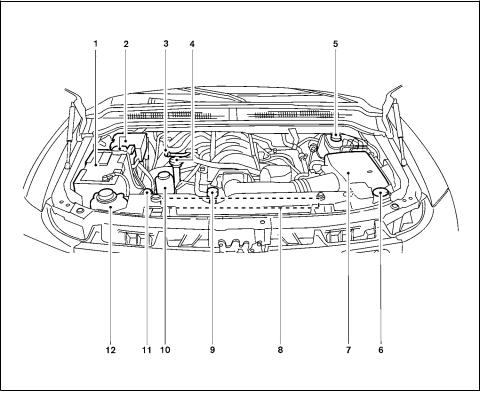
ENGINE COMPARTMENT CHECK
LOCATIONS
1. Battery (P. 8-13)
2. Fuse/fusible link box (P. 8-23)
3. Transmission dipstick (P. 8-11)
4. Engine oil filler cap (P. 8-8)
5. Brake fluid reservoir (P. 8-12)
6. Windshield washer fluid reservoir (P. 8-12)
7. Air cleaner (P. 8-17)
8. Drive belt location (P.8-15)
9. Radiator cap (P. 8-7)
10. Power steering fluid reservoir (P. 8-11)
11. Engine oil dipstick (P. 8-8)
12. Engine coolant reservoir (P. 8-7)
See the page number indicated in parentheses for operating details.
WDI0630
0-8 Illustrated table of contents

WARNING/INDICATOR LIGHTS
Warning |
Name |
Page |
light |
|
|
|
|
|
|
Anti-lock Braking |
2-9 |
or |
System (ABS) warn- |
|
ing light |
|
|
|
|
|
|
|
|
|
Automatic transmis- |
2-9 |
|
sion check warning |
|
|
light |
|
|
|
|
|
Automatic transmis- |
2-9 |
|
sion park warning |
|
|
light ( |
|
|
model) |
|
|
|
|
|
Brake warning light |
2-9 |
or |
|
|
|
|
|
|
Charge warning |
2-10 |
|
light |
|
|
|
|
|
Check suspension |
2-10 |
|
warning light |
|
|
|
|
Warning |
|
Name |
Page |
light |
|
|
|
|
|
|
|
|
Engine oil pressure |
2-10 |
|
|
low/engine coolant |
|
|
|
temperature high |
|
|
|
warning light |
|
|
|
|
|
|
|
4WD warning light |
2-11 |
|
|
( |
model) |
|
|
|
|
|
|
Low fuel warning |
2-11 |
|
|
light |
|
|
|
|
|
|
|
Low tire pressure |
2-11 |
|
|
warning light |
|
|
|
|
|
|
|
Master warning light |
2-12 |
|
|
|
|
|
|
Seat belt warning |
2-13 |
|
|
light and chime |
|
|
|
|
|
|
|
Supplemental air |
2-13 |
|
|
bag warning light |
|
|
|
|
|
|
Indicator |
Name |
Page |
light |
|
|
|
|
|
|
Front passenger air |
2-13 |
|
bag status light |
|
|
|
|
|
High beam indicator |
2-13 |
|
light (Blue) |
|
|
|
|
|
Malfunction indica- |
2-14 |
|
tor lamp (MIL) |
|
|
|
|
|
Security indicator |
2-14 |
|
light |
|
|
|
|
|
Slip indicator light |
2-14 |
|
|
|
|
Turn signal/hazard |
2-15 |
|
indicator lights |
|
|
|
|
|
Vehicle Dynamic |
2-15 |
|
Control (VDC) off |
|
|
indicator light |
|
|
|
|
Illustrated table of contents 0-9
MEMO
0-10 Illustrated table of contents

1 Safety—Seats, seat belts and supplemental restraint system
Seats . . . . . . . . . . . . . . . . . . . . . . . . . . . . . . . . . . . . . . . . . . . . 1-2 Front power seat adjustment. . . . . . . . . . . . . . . . . . . . . 1-3 2nd row captain’s chair adjustment
(if so equipped) . . . . . . . . . . . . . . . . . . . . . . . . . . . . . . . . 1-4 2nd row bench seat adjustment
(if so equipped) . . . . . . . . . . . . . . . . . . . . . . . . . . . . . . . . 1-5 Armrests . . . . . . . . . . . . . . . . . . . . . . . . . . . . . . . . . . . . . . 1-7 Head restraints. . . . . . . . . . . . . . . . . . . . . . . . . . . . . . . . . 1-7 Adjustable headrest (if so equipped). . . . . . . . . . . . . 1-11 Flexible seating. . . . . . . . . . . . . . . . . . . . . . . . . . . . . . . . 1-14 3rd row power folding seats . . . . . . . . . . . . . . . . . . . . 1-18
Seat belts . . . . . . . . . . . . . . . . . . . . . . . . . . . . . . . . . . . . . . . 1-20 Precautions on seat belt usage. . . . . . . . . . . . . . . . . . 1-20 Pregnant women . . . . . . . . . . . . . . . . . . . . . . . . . . . . . . 1-23 Injured persons. . . . . . . . . . . . . . . . . . . . . . . . . . . . . . . . 1-23 Three-point type seat belt with retractor . . . . . . . . . . 1-23 Seat belt extenders . . . . . . . . . . . . . . . . . . . . . . . . . . . . 1-29 Seat belt maintenance . . . . . . . . . . . . . . . . . . . . . . . . . 1-29
Child safety . . . . . . . . . . . . . . . . . . . . . . . . . . . . . . . . . . . . . . 1-30 Infants. . . . . . . . . . . . . . . . . . . . . . . . . . . . . . . . . . . . . . . . 1-30 Small children . . . . . . . . . . . . . . . . . . . . . . . . . . . . . . . . . 1-30 Larger children . . . . . . . . . . . . . . . . . . . . . . . . . . . . . . . . 1-31
Child restraints . . . . . . . . . . . . . . . . . . . . . . . . . . . . . . . . . . . 1-31 Precautions on child restraints . . . . . . . . . . . . . . . . . . 1-31 LATCH (Lower Anchors and Tethers for
CHildren) System . . . . . . . . . . . . . . . . . . . . . . . . . . . . . 1-33 Rear-facing child restraint installation using
LATCH . . . . . . . . . . . . . . . . . . . . . . . . . . . . . . . . . . . . . . . 1-37 Rear-facing child restraint installation using
the seat belts . . . . . . . . . . . . . . . . . . . . . . . . . . . . . . . . . 1-39 Forward-facing child restraint installation
using LATCH. . . . . . . . . . . . . . . . . . . . . . . . . . . . . . . . . . 1-42 Forward-facing child restraint installation
using the seat belts . . . . . . . . . . . . . . . . . . . . . . . . . . . . 1-44 Installing top tether strap
(2nd row captain’s chairs or 2nd row bench
seat [if so equipped] ) . . . . . . . . . . . . . . . . . . . . . . . . . . 1-47 Installing top tether strap
(3rd row bench seat). . . . . . . . . . . . . . . . . . . . . . . . . . . 1-48 Booster seats . . . . . . . . . . . . . . . . . . . . . . . . . . . . . . . . . 1-49 Supplemental restraint system . . . . . . . . . . . . . . . . . . . . . 1-52
Precautions on supplemental restraint
system . . . . . . . . . . . . . . . . . . . . . . . . . . . . . . . . . . . . . . . 1-52 Supplemental air bag warning labels. . . . . . . . . . . . . 1-66 Supplemental air bag warning light . . . . . . . . . . . . . . 1-67
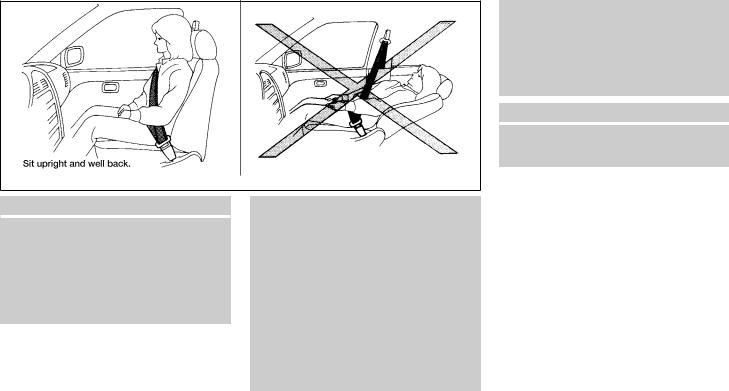
SEATS
ARS1152
WARNING
●Do not ride in a moving vehicle when the seatback is reclined. This can be dangerous. The shoulder belt will not be against your body. In an accident, you could be thrown into it and receive neck or other serious injuries. You could also slide under the lap belt and receive serious internal injuries.
●For the most effective protection when the vehicle is in motion, the seat should be upright. Always sit well back in the seat with both feet on the floor and adjust the seat properly. See “Precautions on seat belt usage” later in this section.
●After adjustment, gently rock in the seat to make sure it is securely locked.
●Do not leave children unattended inside the vehicle. They could unknowingly activate switches or controls. Unattended children could become involved in serious accidents.
1-2 Safety—Seats, seat belts and supplemental restraint system
●The seatback should not be reclined any more than needed for comfort. Seat belts are most effective when the passenger sits well back and straight up in the seat. If the seatback is reclined, the risk of sliding under the lap belt and being injured is increased.
CAUTION
When adjusting the seat positions, be sure not to contact any moving parts to avoid possible injuries and/or damage.
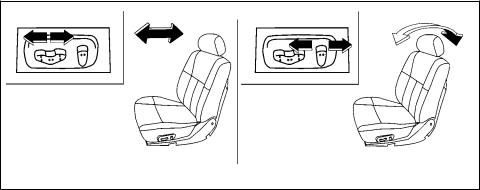
belt fit (see “Precautions on seat belt usage” later in this section). Also, the seatback can be reclined to allow occupants to rest when the vehicle is stopped and the shift selector is in P (Park).
WRS0163
FRONT POWER SEAT
ADJUSTMENT
Operating tips
●The power seat motor has an auto-reset overload protection circuit. If the motor stops during operation, wait 30 seconds, then reactivate the switch.
●Do not operate the power seat switch for a long period of time when the engine is off. This will discharge the battery.
Forward and backward
Moving the switch forward or backward will slide the seat forward or backward to the desired position.
Reclining
Move the recline switch backward until the desired angle is obtained. To bring the seatback forward again, move the switch forward and move your body forward. The seatback will move forward.
See “Automatic drive positioner” in the “Pre- |
The reclining feature allows adjustment of the |
driving checks and adjustments” section for au- |
seatback for occupants of different sizes for |
tomatic drive positioner operation. |
added comfort and to help obtain proper seat |
|
Safety—Seats, seat belts and supplemental restraint system 1-3 |

WRS0164
Seat lifter
Push the front or rear end of the switch up or down to adjust the angle and height of the seat cushion.
LRS0238
Lumbar support
The lumbar support feature provides lower back support to the driver. Move the switch forward or backward to adjust the seatback lumbar area.
WRS0369
2ND ROW CAPTAIN’S CHAIR ADJUSTMENT (if so equipped)
Reclining
To recline the seatback, pull up on the lever and lean back.
The recline feature allows adjustment of the seatback for occupants of different sizes for added comfort and to help obtain proper seat belt fit (see “Precautions on seat belt usage” later in this section). Also, the seatback can be reclined to allow occupants to rest when the vehicle is stopped and the shift selector is in P (Park).
1-4 Safety—Seats, seat belts and supplemental restraint system

WRS0415
Tip up for easy entry to the 3rd row
The 2nd row captain’s chairs can be tipped forward for easy entry or exit from the 3rd row bench seat. To enter the 3rd row 1 , raise the armrest so it is parallel to the seatback and in the stowed position, then lift up on the seatback latch located on the upper corner of the seatback on the 2nd row captain’s chair and fold the seatback forward at an angle over the seat base. This will release the back of the seat so it may be tipped forward.
LRS0372
Then 2 lift up on the lower corner of the seat base and tip the 2nd row captain’s chair forward. To exit the 3rd row bench seat, lift up on the same seatback latch and fold the seatback forward onto the seat base. Then lift up on the seat base and tip it forward.
WRS0369
Outboard seats
2ND ROW BENCH SEAT ADJUSTMENT (if so equipped)
Reclining
To recline the seatback, pull up on the lever and lean back.
The recline feature allows adjustment of the seatback for occupants of different sizes for added comfort and to help obtain proper seat belt fit (see “Precautions on seat belt usage” later in this section). Also, the seatback can be reclined to allow occupants to rest when the vehicle is stopped and the shift selector is in P (Park).
Safety—Seats, seat belts and supplemental restraint system 1-5

WARNING
●After adjustment, gently rock in the seat to make sure it is securely locked.
●Do not ride in a moving vehicle when the seatback is reclined. This can be dangerous. The shoulder belt will not be against your body. In an accident, you could be thrown into it and receive neck or other serious injuries. You could also slide under the lap belt and receive serious internal injuries.
●For the most effective protection when the vehicle is in motion, the seat should be upright. Always sit well back in the seat and adjust the seat belt properly. See “Precautions on seat belt usage” later in this section.
WRS0414
Tip up for easy entry to the 3rd row
The outboard seating positions on the 2nd row bench seat can be tipped forward for easy entry or exit from the 3rd row bench seat. To enter the 3rd row 1 , lift up on the seatback latch located on the upper corner of the seatback on the 2nd row bench seat and fold the seatback forward at an angle over the seat base. This will release the back of the seat so it may be tipped forward.
LRS0331
Then 2 lift up on the lower corner of the seat base and tip the outboard seating position of the 2nd row bench seat forward. To exit the 3rd row bench seat, lift up on the same seatback latch and fold the seatback forward onto the seat base. Then lift up on the seat base and tip it forward.
1-6 Safety—Seats, seat belts and supplemental restraint system
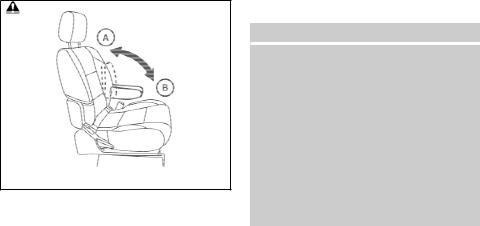
WRS0368
ARMRESTS
To use the armrests, pull them down to the resting position.
A Stowed position
B Resting position
HEAD RESTRAINTS
WARNING
Head restraints supplement the other vehicle safety systems. They may provide additional protection against injury in certain rear end collisions. Adjust the head restraints properly, as specified in this section. Check the adjustment after someone else uses the seat. Do not attach anything to the head restraint stalks or remove the head restraint. Do not use the seat if the head restraint has been removed. Failure to follow these instructions can reduce the effectiveness of the head restraints. This may increase the risk of serious injury or death in a collision.
Safety—Seats, seat belts and supplemental restraint system 1-7

The illustration shows the seating positions equipped with head restraints. All of the head restraints are adjustable.
Indicates the seating position is equipped with a head restraint.
LRS0886 |
|
LRS0887 |
Components
1.Head restraint
2.Adjustment notches
3.Lock knob
4.Stalks
1-8 Safety—Seats, seat belts and supplemental restraint system

WRS0134 |
|
LRS0888 |
|
LRS0889 |
Adjustment |
To raise the head restraint, pull it up. |
Adjust the head restraint so the center is level with the center of the seat occupant’s ears.
To lower, push and hold the lock knob and push the head restraint down.
Safety—Seats, seat belts and supplemental restraint system 1-9

LRS0890
Removal
Use the following procedure to remove the adjustable head restraints.
1.Pull the head restraint up to the highest position.
2.Push and hold the lock knob.
3.Remove the head restraint from the seat.
4.Store the head restraint properly so it is not loose in the vehicle.
5.Install and properly adjust the head restraint before an occupant uses the seating position.
LRS0891
Install
1.Align the head restraint stalks with the holes in the seat. Make sure the head restraint is
facing the correct direction. The stalk with
the adjustment notches 1 must be installed in the hole with the lock button 2 .
2.Push and hold the lock knob and push the head restraint down.
3.Properly adjust the head restraint before an occupant uses the seating position.
1-10 Safety—Seats, seat belts and supplemental restraint system
SPA1025
Front-seat Active Head Restraints
The Active Head Restraint moves forward utilizing the force that the seatback receives from the occupant in a rear-end collision. The movement of the head restraint helps support the occupant’s head by reducing its backward movement and helping absorb some of the forces that may lead to whiplash-type injuries.
Active Head Restraints are effective for collisions at low to medium speeds in which it is said that whiplash injury occurs most.
Active Head Restraints operate only in certain rear-end collisions. After the collision, the head restraints return to their original position.
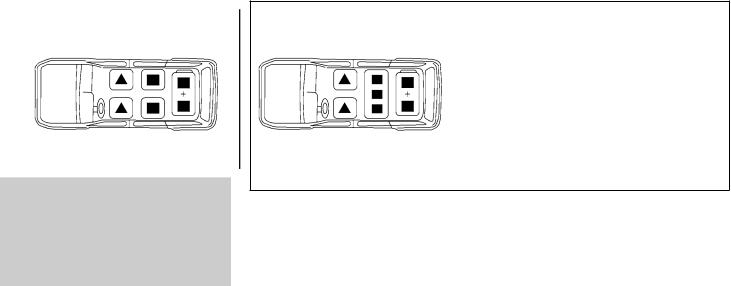
Adjust the Active Head Restraints properly as described in this section.
ADJUSTABLE HEADREST (if so equipped)
WARNING
The adjustable headrests supplement the other vehicle safety systems. They may provide additional protection against injury in certain rear end collisions. Adjust the headrests properly, as specified in this section. Check the adjustment after someone else uses the seat. Do not attach anything to the adjustable headrest stalks or remove the adjustable headrests. Do not use the seat if the adjustable headrests have been removed. Failure to follow these instructions can reduce the effectiveness of the adjustable headrests. This may increase the risk of serious injury or death in a collision.
LRS0892
The illustration shows the seating positions equipped with adjustable headrests. All of the headrests are adjustable.
Indicates the seating position is equipped with an adjustable headrest.
+ Indicates the seating position is not equipped with a head restraint or adjustable headrest.
Safety—Seats, seat belts and supplemental restraint system 1-11

|
LRS0887 |
|
WRS0134 |
|
LRS0888 |
Components |
Adjustment |
To raise the headrest, pull it up. |
|||
1. |
Adjustable headrest |
Adjust the headrest so the center is level with the |
|
||
2. |
Adjustment notches |
center of the seat occupant’s ears. |
|
||
|
|
|
|
||
3. |
Lock knob |
|
|
|
|
4. |
Stalks |
|
|
|
|
1-12 Safety—Seats, seat belts and supplemental restraint system

LRS0889
To lower, push and hold the lock knob and push the headrest down.
LRS0890
Removal
Use the following procedure to remove the adjustable headrests.
1.Pull the headrest up to the highest position.
2.Push and hold the lock knob.
3.Remove the headrest from the seat.
4.Store the headrest properly so it is not loose in the vehicle.
5.Install and properly adjust the headrest before an occupant uses the seating position.
LRS0891
Install
1.Align the headrest stalks with the holes in the seat. Make sure the headrest is facing
the correct direction. The stalk with the ad-
justment notches 1 must be installed in the hole with the lock button 2 .
2.Push and hold the lock knob and push the headrest down.
3.Properly adjust the headrest before an occupant uses the seating position.
Safety—Seats, seat belts and supplemental restraint system 1-13
